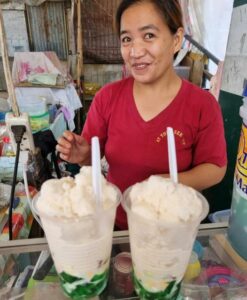By Waya Araos-Wijangco
IN THE sweltering metropolis, one of the best ways to cool down is to indulge in an icy traditional summer treat — the halo-halo.
Halo-halo (Filipino for “mixed”) is, well, a mix of crushed or shaved ice, local sweets, and milk. Sometimes it is made “special” with a scoop of ice cream. The variations are endless, and a halo-halo can be as simple or as complex as one wants.
Chef Waya Araos-Wijangco has taken it upon herself, in this summer’s extreme heat, to try as many kinds of halo-halo as she can for as long as the heat is on. Over the past couple of weeks, the executive chef and owner of GypsyBaguio by Chef Waya, tried X number and this is what she thought of the traditional summer coolers as per her Facebook posts.
*For those unfamiliar with the ingredients mentioned, here is a simple glossary: bilo-bilo (small glutinous rice balls), buco (immature coconut, can refer to both its meat and juice), camote (sweet potato), gulaman (jel-ly), kaong (sugar palm fruit), langka (jackfruit), leche flan (a flan), macapuno (coconut sport), monggo (mung beans), nata (coconut gel), pinipig (flattened immature glutinous rice grains), saba (a cooking banana), sago (tapioca-like balls made of sago palm flour), tocino del cielo (a Spanish dessert made of egg yolks, sugar, and water), ube (purple yam), ube halaya (a dessert made of purple yam, coconut milk, and butter).
** The posts were edited for length and clarity.
VICTORINO’S
Took shelter from the sweltering heat in the cool, comforting confines of Victorino’s and had the best halo-halo of the season. Made with two kinds of camote, saba, langka, bilo-bilo, chunky macapuno, leche flan, cheese, and topped with a ridiculously indulgent tocino del cielo. This halo-halo is perfection!
DIMPY’S
Dimpy’s became famous for their frozen brazo de mercedes (still good, by the way). They started in Dasmariñas Village in Makati and opened an outpost in BF Parañaque. I heard they had halo-halo so off I went to try. The Dimpy’s version wins in color-blocking. Very pretty presentation. It doesn’t have a lot of stuff in it but what they put in made sense together — gulaman, kaong, saba, langka, and a huge chunk of leche flan and their housemade ube gelato. My favorite part of it is their shaved ice. So finely shaved it contributed to the creaminess of the halo-halo.
LOTUSPOD
Halo-halo served in the shell of the buco used to be popular, but the rising cost of fresh coconut in the city rendered it difficult to execute in restaurants. So I was so happy to find it in the gem of a resort in Bay, Laguna called @Lotuspod. The sinkers are classic: red bean, saba, langka, nata de coco, kaong. It is topped with leche flan, ube ice cream and cornflakes. What makes it special is that while you are eating it, you are scraping the buco meat from the sides of the shell and including a piece of coconut in every bite. And because they harvest the coconuts right at the resort, you get it fresh and sweet and at the level of maturity you want. You can even request to have the buco water on the side! Nothing beats this combination after a dip in the pool!
COCONUT HOUSE BUCO HALO
I first came across the Coconut House Buco Halo in 2018. I remember that summer when we would order from their Quezon Circle branch almost three times a week. They closed the Quezon Circle in the pandemic and they are now available at Gyud Food, Diliman, QC. The ice they use is finely shaved buco water, so the halo-halo flavor does not get watered down as it melts. The sinkers are saba, buco, sago, and topped with leche flan, buco ice cream and coconut cream. It feels light and refreshing from the buco water and it has just enough fillings for chew but does not overwhelm. This one is the best one I had by far.
LITTLE QUIAPO
Midway into my halo-halo journey, I find that part of the joy of eating it is that it triggers memories of halo-halo from summers and vacations and places I have been to… Today’s halo-halo was a sentimental choice. As a student in UP Diliman we would head out to Little Quiapo (LQ), then on Matalino Street for palabok (a noodle dish) and halo-halo. When we were running for student council, LQ was a regular dinner option after a long day of dorm-to-dorm campaigning. The LQ halo-halo is classic, sinkers (finally found the right term!) include nata de coco, langka, banana, kamote, red monggo and buco. Toppers are leche flan, ube ice cream, and pinipig.
NATHANIEL’S
Was busy at work today and had no time to go out to eat. But I am committed to the halo-halo mission so I looked for a delivery option. Went with @nathanielsph located in BF Parañaque. Nathaniel’s is a Pampanga institution famous for their buko pandan (a dessert made with young coconut, pandan leaves, and sago pearls. — Ed.) and puto pao (a rice cake with meat filling. — Ed.) Their halo-halo arrived still frozen, with the milk and cornflakes topping thoughtfully packed separately. You could see that almost a third of the glass was generously filled with the “toppings.” It had all the classics, banana, langka, red and white beans, gulaman, nata, really good leche flan and ube ha-laya, and a big scoop of ube ice cream. The ice was not finely shaved [as Dimpy’s was] but I realized I also like ice with a pleasant crunch.
SABLAN
The Sablan, Benguet halo-halo is made with sweetened saba, gulaman, and, wait for it, marshmallows. For a while there I thought even the gummy bears would make it into the mix. Served with a wide smile and consumed with empathy and grace.
